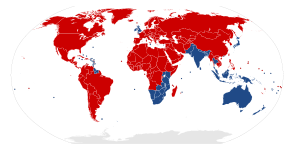|
Why Left Hand Traffic, in the UK?
We, in the UK, are one of the countries in the world who drive on the left hand side of the road. We're part of a minority of 34%, as depicted on the map in blue. The majority, at 66%, drive on the right, including most of mainland Europe, and are detailed on the map in red. The only European countries who don't drive on the right are the UK; Ireland; Malta and Cyprus. So why do we drive on the left?It's widely accepted to be related to the practicalities, and niceties, of a time when most people travelled on horses or horse-drawn vehicles and the fact that the majority of people are right-handed. The theories below generally cover the main reasons why we drive on the left.
The first written Act in the UK to stipulate that traffic must drive on the left hand side of the road was The Highway Act of 1773, and was in reference to traffic crossing London Bridge. This was then passed into law as a general 'rule' in The Highway Act (1835).
There is, however, substantial evidence that left hand traffic has been the preferred option since at least Roman times in Britain. Archaeologists have excavated many sites where there are deeply gouged tracks on the left side of roads into towns and cities. The depth of the tracks going into these areas are significantly deeper than the grooves travelling out. This suggests that full, heavily-laden carts, possibly on the way into towns to sell goods at market, travelled on the left, causing deep grooves on entering. The grooves on the right hand side of the road, speculated to denote travel out of the towns, have proved to be shallower. It is thought that this is because the goods must have been sold and the carts, therefore, would have been much lighter, carrying far smaller loads.
There are a few theories about why many countries changed to driving on the right. All of these theories, more than likely, could have had some part to play in different countries.
The first rule of the road.Whichever side is adopted, by whichever country, organised traffic flow is fundamentally dependent on whether left hand traffic is legislated, or it's right hand traffic that's stipulated. Whichever side, that is what dictates how the rest of the 'rules of the road' are structured and organised. e.g. on roundabouts in countries where the rule is to drive on the left, traffic travels clockwise around the roundabout, whereas, in countries where it's stipulated to drive on the right, traffic travels in an anti-clockwise direction around the roundabout. Therefore, all other 'rules of the road' stem from which side of the road directs the flow of traffic. This makes the side of the road the '1st rule of the road' and ultimately the most important rule of the road, and this is consistent across all countries.
Return from Left Hand Traffic to UK Driving Licence Page
|

